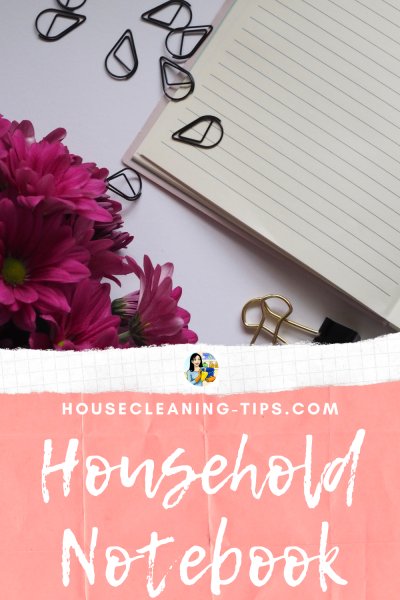- Are you new to housecleaning-tips.com: Start Here
- Claim your free copy of our Special Report: "How To Clean Your House: Advice From the Past"
The Household Notebook: Keeping Your Household Organized With a 3 Ring Binder
The household notebook is one of those home management tools that can help you stay on top of your home life. In this article you will learn about the benefits of having your own household notebook, and help you get started with 10 essential cleaning lists you should keep in it.
In the old days the household notebook was common place. Women would pass down the housecleaning tips, recipes for cooking, and recipes for homemade cleaning products and remedies for cuts and bruises, daily schedules and meal plans. A lot of this wisdom was bound in scrapbooks (a.k.a. Household Notebook).
Today, there seems to be a much needed revival of this tradition. The idea of creating a household notebook is more like making a home management system. A system for keeping you organized, your family organized and your home organized.
Creating a household notebook will help reduce or eliminate chaos.
You know what I mean!
The Benefits of Using a Household Notebook
If you are anything like me you know that there is work to be done - you see it all around you. The floors need mopping, the windows need cleaning, you dread opening the refrigerator, the laundry is piling up and only you can distinguish the clean from the not so clean.
Not only that, but you might live with the others who don't have a clue about cleaning or where they're supposed to be at a certain time.
Fill it with family schedules, meal plan, chore charts, grocery lists etc. This way everyone in the family knows what it takes to run the household they live in.
The household notebook can be made to suit your life at home. If you have a large family you can or must include schedules, chore charts, emergency contact numbers, meal plans, medical info, bills etc...
If you home-school your children you can add a section to you household notebook. Or if it's just you and you spouse, you can include travel information, training, warranties, budgets and medical information. You see the household notebook is flexible and you can create it according to your needs.
There is however - one small but important caveat about the household notebook. There are some bits of information you do not want to place in the household notebook. Like if you do online banking or shopping online - don't put your password information in the notebook. Look at it this way. When creating your notebook - picture your worst enemy casually browsing through.
If there is any part that you would die if they see it, then don't include it in your household notebook.
10 Essential Cleaning Lists You Should Include in Your Household Notebook
Inventory of cleaning supplies - including machines such as vacuum cleaners, equipment such as mops and brooms and cleaning solutions such as dishwashing liquid.
The purpose of this inventory is to ensure that you have everything that you need before you start a clean session. I find that nothing is more demotivating than to be in the middle of a cleaning task and realizing that I don't have the right tools or enough cleaning products.
List of items to regularly inspect for damage. Include the date the item was last inspected. There are two reasons this list is important.
First, you don't want your home to be a mystery to you. For example - you should know if something just does not sound right. Second, the earlier you see a problem the less it will cost to repair then. Waiting to fix an issue or just not seeing until it is really bad, can be more expensive to deal with.
Maintain list of items that need to be repaired. This goes along with the previous point. You don't want items to be on this list for long. For me, what mainly ends up on my list is splintered legs on wooden furniture.
Checklist of frequently touched items. The purpose of this list is to cleaning these items and spaces daily to lower the risk of spreading germs.
List of daily cleaning tasks that fit into your morning and evening cleaning routines.
List of items that should never be allowed back into your home. This list can be created as you declutter.
List of annual and monthly cleaning tasks. Since these happen rarely, they can be easy to forget. So write them done and include them in your weekly cleaning schedule when the time comes to get them done.
A list the maps items to places where they should be. This one can be optional - mainly used to help get little ones to put stuff back in their rightful place. Also, if you're not around to do it - would everyone else in the home know where everything should be - or for that matter, know where everthing is?
List of homemade cleaning product recipes and ingredients and what they are best used for.
List of companies that recycle electronic products, that accept donations of books, clothes and furniture. I'm sure you know by now, that while it's easy to buy stuff - getting rid of things can be challenging and time consuming. Having this list at hand can at least save you some time.

Finally, to make checklists for your household notebook - you can use the online checklist maker here. Be sure to read to instructions at the bottom of the page.


